
The First Sino-Japanese War, or the First China–Japan War, was a conflict between the Qing dynasty of China and the Empire of Japan primarily over influence in Korea. In Chinese it is commonly known as the Jiawu War. After more than six months of unbroken successes by Japanese land and naval forces and the loss of the ports of Lüshunkou and Weihaiwei, the Qing government sued for peace in February 1895 and signed the unequal Treaty of Shimonoseki two months later, ending the war.

The Meiji era was an era of Japanese history that extended from October 23, 1868, to July 30, 1912. The Meiji era was the first half of the Empire of Japan, when the Japanese people moved from being an isolated feudal society at risk of colonization by Western powers to the new paradigm of a modern, industrialized nation state and emergent great power, influenced by Western scientific, technological, philosophical, political, legal, and aesthetic ideas. As a result of such wholesale adoption of radically different ideas, the changes to Japan were profound, and affected its social structure, internal politics, economy, military, and foreign relations. The period corresponded to the reign of Emperor Meiji. It was preceded by the Keiō era and was succeeded by the Taishō era, upon the accession of Emperor Taishō.

The Last Samurai is a 2003 American epic period action drama film directed and produced by Edward Zwick, who also co-wrote the screenplay with John Logan and Marshall Herskovitz from a story devised by Logan. The film stars Tom Cruise, who also produced, along with Timothy Spall, Ken Watanabe, Billy Connolly, Tony Goldwyn, Hiroyuki Sanada, and Koyuki Kato in supporting roles. The film's plot was inspired by the 1877 Satsuma Rebellion, led by Saigō Takamori, and the Westernization of Japan by foreign powers.

Ōmura Masujirō was a Japanese military leader and theorist in Bakumatsu period Japan. He was the "Father" of the Imperial Japanese Army, launching a modern military force closely patterned after the French system of the day.

Saigō Takamori was a Japanese samurai and nobleman. He was one of the most influential samurai in Japanese history and one of the three great nobles who led the Meiji Restoration. Living during the late Edo and early Meiji periods, he later led the Satsuma Rebellion against the Meiji government. Historian Ivan Morris described him as "the quintessential hero of modern Japanese history".

The Boshin War, sometimes known as the Japanese Revolution or Japanese Civil War, was a civil war in Japan fought from 1868 to 1869 between forces of the ruling Tokugawa shogunate and a coalition seeking to seize political power in the name of the Imperial Court.

The Satsuma Rebellion, also known as the Seinan War, was a revolt of disaffected samurai against the new imperial government of the Empire of Japan, nine years into the Meiji era. Its name comes from the Satsuma Domain, which had been influential in the Restoration and became home to unemployed samurai after military reforms rendered their status obsolete. The rebellion lasted from 29 January until 24 September of 1877, when it was decisively crushed, and its leader, Saigō Takamori, was shot and mortally wounded.
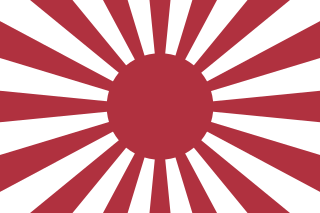
The Imperial Japanese Army (IJA) was the principal ground force of the Empire of Japan. Forming one of the military branches of the Imperial Japanese Armed Forces (IJAF), it was controlled by the Imperial Japanese Army General Staff Office and the Army Ministry, both of which were nominally subordinate to the Emperor of Japan, the supreme commander of IJAF. During the 20th century, an Inspectorate General of Aviation became the third agency with oversight of the IJA. At its height, the IJA was one of the most influential factions in the politics of Japan.
This article is concerned with the events that preceded World War II in Asia.
In Japanese military history, the modernization of the Japanese army and navy during the Meiji period (1868–1912) and until the Mukden Incident (1931) was carried out by the newly founded national government, a military leadership that was only responsible to the Emperor, and with the help of France, Britain, and later Germany.
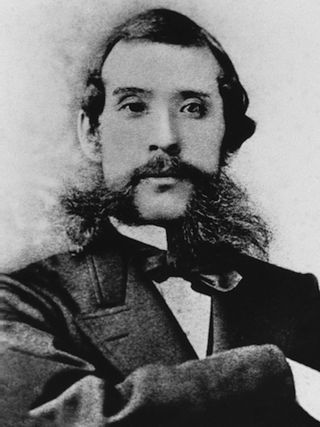
The Meiji oligarchy was the new ruling class of Meiji period Japan. In Japanese, the Meiji oligarchy is called the domain clique.

The Hibiya incendiary incident, also known as the Hibiya riots, was a major riot that occurred in Tokyo, Japan, from 5 to 7 September 1905. Protests by Japanese nationalists in Hibiya Park against the terms of the Treaty of Portsmouth ending the Russo-Japanese War escalated into a violent two-day citywide riot when the police attempted to suppress the protests. The Hibiya incendiary incident resulted in the death of 17 rioters, led to the collapse of the government of Katsura Tarō, and is considered the first event of the Era of Popular Violence. Over 2000 rioters were later arrested for their involvement, with 104 being tried and 87 found guilty.
The Akizuki rebellion was an uprising against the Meiji government of Japan that occurred in Akizuki from 27 October 1876 to 24 November 1876.
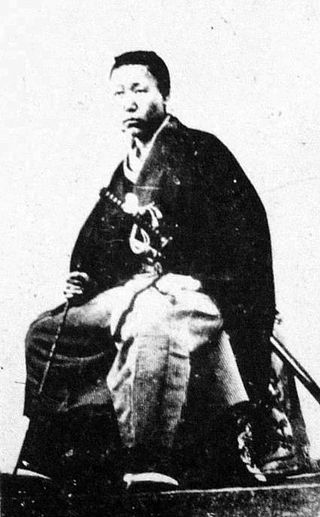
The Hagi Rebellion was an uprising against the Meiji government of Japan that occurred in Hagi from 28 October 1876 to 5 November 1876.
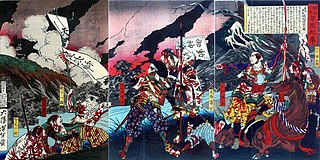
The Shinpūren rebellion was an uprising against the Meiji government of Japan that occurred in Kumamoto on 24 October 1876.
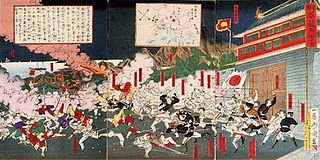
The Imo Incident, also sometimes known as the Imo Mutiny, Soldier's riot or Jingo-gunran in Japanese, was a violent uprising and riot in Seoul beginning in 1882, by soldiers of the Joseon Army who were later joined by disaffected members of the wider Korean population. The revolt broke out in part due to King Gojong's support for reform and modernization, as well as the employment of Japanese military advisors. Some sources credit rumors as the spark which ignited violence, where many Korean soldiers were worried by the prospect of incorporating Japanese officers in a new army structure. The trigger for the riot is largely attributed to a reaction about unpaid soldiers wages, who found sand and bad rice in soldiers' rations. At the time, soldiers could be paid in rice as it was used in place of currency.

Mutsuhito, posthumously honored as Emperor Meiji, was the 122nd emperor of Japan according to the traditional order of succession, reigning from 1867 until his death in 1912. His reign is associated with the Meiji Restoration of 1868, which ended the Tokugawa shogunate and began rapid changes that transformed Japan from an isolationist, feudal state to an industrialized world power. Emperor Meiji was the first monarch of the Empire of Japan, and presided over the Meiji era.

The Meiji Restoration, referred to at the time as the Honorable Restoration, and also known as the Meiji Renovation, Revolution, Regeneration, Reform, or Renewal, was a political event that restored practical imperial rule to Japan in 1868 under Emperor Meiji. Although there were ruling emperors before the Meiji Restoration, the events restored practical abilities and consolidated the political system under the Emperor of Japan. The goals of the restored government were expressed by the new emperor in the Charter Oath.

The Imperial Japanese Armed Forces were the unified forces of the Empire of Japan. Formed during the Meiji Restoration in 1868, they were disbanded in 1945, shortly after Japan's defeat to the Allies of World War II; the revised Constitution of Japan, drafted during the Allied occupation of Japan, replaced the IJAF with the present-day Japan Self-Defense Forces.

The Joseon Army of the late 19th century was the modernized army of the Korean dynasty of Joseon. After the Treaty of Ganghwa, King Gojong and Queen Myeongseong spearheaded the modernization of the armed forces. The army was known for the Donghak Peasant Revolution, its defense of Gyeongbokgung Palace, and defending Queen Min from the Japanese. Despite this, the new modernized army was too weak to defend itself from foreign threats and could not prevent the assassination of Queen Min. Gojong declared Joseon the Empire of Korea and contributed the modernization of the armed forces.


















